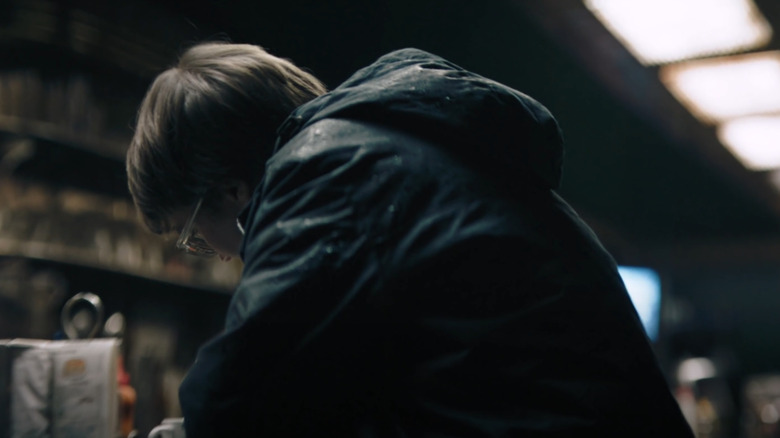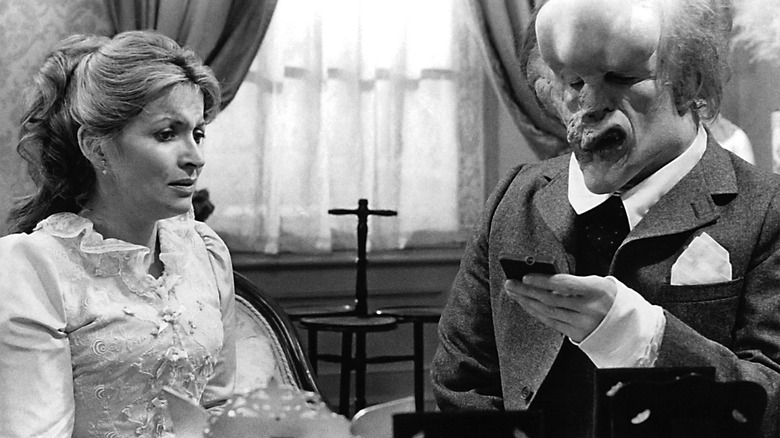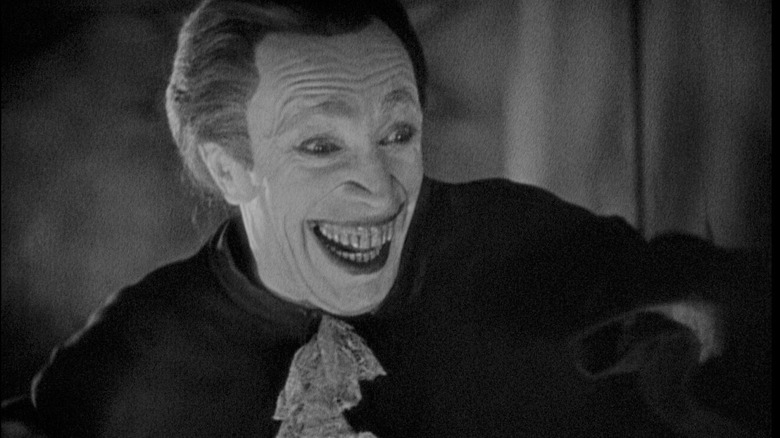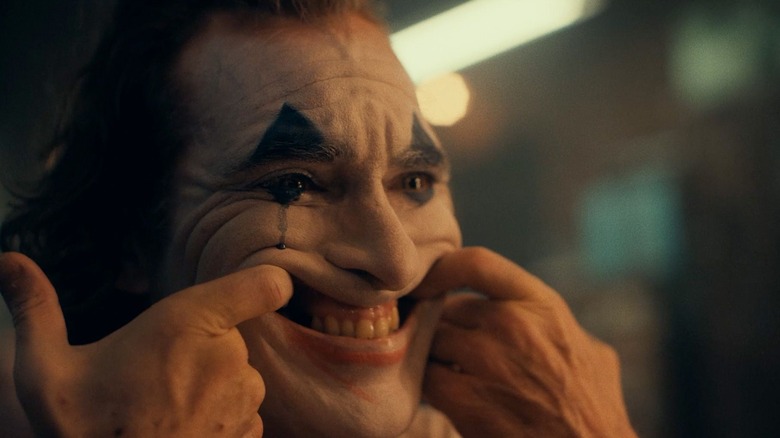The Batman's Big Cameo Can Be Traced Right Back To David Lynch
This article contains a spoiler for the final scenes of "The Batman."
Near the end of "The Batman," after the Riddler has been apprehended and escorted to his own private cell at Arkham Asylum (in this film, a smaller, more clinical place when compared to the Hammer-movie/haunted-castle version of previous films), he finds himself destitute. He has no friends, Batman wasn't on his wavelength, and he only has time to think about what he did, and what he's going to do about it going forward. One would hope that Gotham City's mental care facilities are better in "The Batman" than they were in 2019's "Joker." Arkham Asylum (which takes its name from the fictional Massachusetts city found in H.P. Lovecraft stories) is a notoriously ill-run hospital in the Batman universe, run more like the Chateau D'If than an actual hospital. Supervillains are sent there only to cause riots and then to break out again. Prison warden Crichton from the 1966 TV series handled supervillains about as well as the administrators of Arkham.
In Arkham, the Riddler hears his cellmate ask a riddle. We only see the cellmate in silhouette, the sun beaming in from behind him. He see his wild hair and a few details on his smiling face. "One day you're on top," he says, "The next day, you're a clown." Although the character is credited as "Unseen Arkham Prisoner," it's quite clear this is director Matt Reeves' version of the Joker. The solution to the Joker's mysterious riddle is "a friend," implying that he and the Riddler will begin an exchange of ideas, feeding one another's propensity for supervillainy. One cannot recognize him on screen, but the Joker is played by actor Barry Keoghan from "Killing of a Sacred Deer" and "Eternals." It wouldn't be a superhero film without a teaser for an upcoming sequel.
Reeves, in a recent interview with IGN, talked about his vision of the Joker, and how this new version — however briefly glimpsed — was, in fact, inspired by the 1980 David Lynch film "The Elephant Man."
The Elephant Man
"The Elephant Man" was Lynch's second feature as a director, and was produced by the legendary comedian Mel Brooks, who offered Lynch funding after being so impressed by Lynch's debut film, "Eraserhead." "The Elephant Man" tells the true story of Joseph Merrick — changed to John for the film — who was born with several medical conditions that left his skin coated with tumors, his arm misshapen, and his head oversized. Merrick (John Hurt) was displayed in circus sideshows. One Dr. Treaves (Anthony Hopkins) takes pity on Merrick, who is treated cruelly by his "owner," a Dickensian villain named Bytes (Freddie Jones). Treaves finds that Merrick is, in fact, intelligent and gentle and has an abiding love for art and theater. "The Elephant Man" was nominated for eight Academy Awards, including Best Actor, Best Director, and Best Picture, but it won none. "Ordinary People" won Best Picture that year.
When it came time to design his own version of the Joker, Matt Reeves was inspired by "The Elephant Man."
Reeves started his design for the Joker on the character of Gwynplaine, played by Conrad Veidt in Paul Leni's 1928 film "The Man Who Laughs," based on a novel by Victor Hugo. The Joker from the comics, first seen in 1940, was originally inspired by Gwynplaine, so "The Man Who Laughs" was merely a logical place to start for any Joker. Gwynplaine has his smile carved into his face. In Tim Burton's 1989 "Batman," the Joker's face was the result of exposure to chemicals and botched corrective plastic surgery. In "The Dark Knight," we don't really know where his scars came from. Reeves wanted the Joker's smile to be something he was born with:
"He's got this congenital disease. He can never stop smiling. And it made Mike [makeup artist Michael Fontaine] and I think about — I was talking about "The Elephant Man" because I love David Lynch. And I was like, "Well, maybe there's something here where it's not something where he fell in a vat of chemicals or it's not the Nolan thing where he has these scars and we don't know where they came from. What if this is something that he's been touched by from birth and that he has a congenital disease that refuses to let him stop smiling? And he's had this very dark reaction to it, and he's had to spend a life of people looking at him in a certain way and he knows how to get into your head."
Smiling since birth
Even though the Joker only plays a small role in "The Batman," the character is significant, positioned, as he is, as Batman's longest-lasting nemesis. As such, Reeves had to be sensitive in creating the look of the Joker, even for a brief cameo. It was important to Reeves to make the character stand out among the character's long, long-running history. The idea that the Joker had been born with a Conrad Vedit-like rictus would indeed be a new take on the character:
"So [it's] this idea of him being very incisive and brilliant and being able to get into your mind and basically having this nihilistic point of view that's like from his inception, from his birth, life has been a cruel joke on him. And this is his response, and he's eventually going to declare himself as a clown, declare himself as the Joker. That was the idea."
In a way, this is the opposite of the story of "The Elephant Man," which is about a man who remained humane and thoughtful, even after years of abuse at the hands of a cruel circus ringmaster. This Joker was to be undone by his infirmities.
The next step for the Joker
Although the bulk of "The Batman" takes a lot of tonal cues, visual elements, and plot points from David Fincher's 1995 film "Seven," Reeves also admitted in the IGN interview that his plan for the Joker was far more elaborate, and was going to take a central notion from "The Silence of the Lambs" as well. In "The Batman," there was to be a scene wherein the title hero must go to Arkham Asylum and consult a prisoner — one with whom he had a past — in order to gain insight into the mind of The Riddler who was still at large. That prisoner was meant to be the Joker, presented like Hannibal Lecter.
But Reeves tested his film without the Joker scenes, and realized the Riddler functioned better without them:
"What you're really seeing is a pre-Joker Joker. And the idea for me, why I kept that scene in the movie, even though I cut the first scene that I'm describing, is because it was important for me at the end. I actually took the scene that's in the movie still out for a brief time. And we tested it, and I realized that for me, on the one hand, it finishes the Riddler's arc, because you know the way his story plays out and you see him in the wake of what's happened and how Batman has been able to thwart what he was doing."
Indeed, saving the threat of the Joker for the future added texture to earlier scenes:
"But it was also this idea that in this moment, now that the stranglehold of Falcone has been broken, it means that there is a moment of not only hope, but it's also the moment of greatest danger in the city in a long time because it means that everyone is going to grab for power. And when Selina is talking to Batman at the end of the movie — and they're having their very poignant goodbye because they're always going to be on the opposite sides of things — she says to him, 'You know this place isn't going to change.' And when I took the [Joker] scene out, the stakes of the scene changed, because that scene shows you that, when she says that, you've just seen it and you see the two of them [Joker and Riddler] next to each other. And that's just one example of how trouble in Gotham is never going to subside. There's always going to be somebody with a plan afoot."
It's entirely likely that a sequel to "The Batman" will be greenlit, as these sorts of things have a tendency to continue indefinitely, so we'll have a chance to catch up with the Joker in the future.



